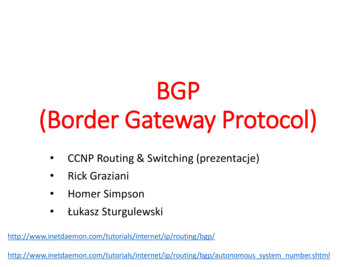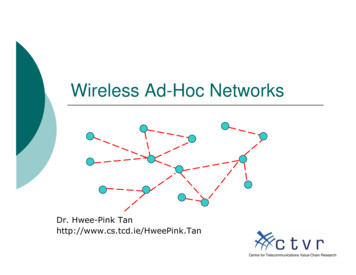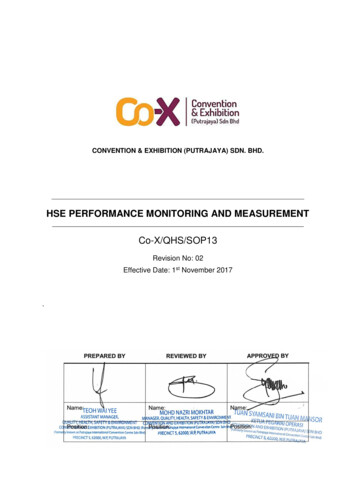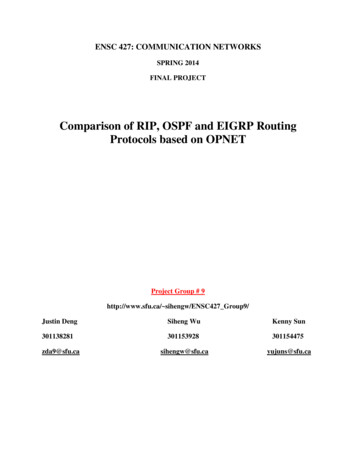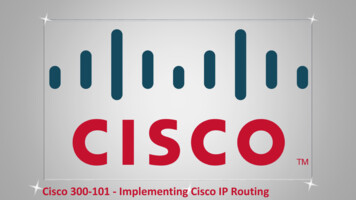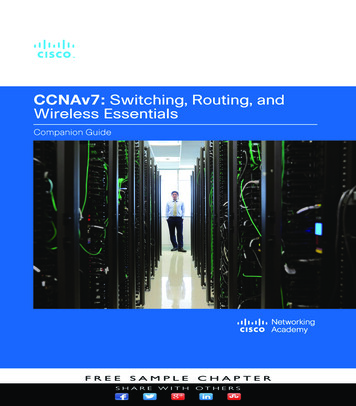
Transcription
International Journal of Scientific and Research Publications, Volume 2, Issue 9, September 2012ISSN 2250-31531Reactive and Proactive Routing Protocol PerformanceEvaluation for Qualitative and Quantitative Analysis inMobile Ad Hoc NetworkPatil V.PSmt. Indira Gandhi College of Engineering, New Mumbai, IndiaAbstract- A mobile ad hoc network (MANET) is a networkconsisting of a set of wireless mobile nodes that communicatewith each other without centralized control or establishedinfrastructure. Every node in MANET moves arbitrarily makingthe multi-hop network topology to change randomly atunpredictable times. There are several familiar routing protocolslike DSDV, AODV, DSR, and OLSR which have been proposedfor providing communication among all the nodes in thenetwork. This paper presents Qualitative and QuantitativeAnalysis of Reactive and Proactive Routing ProtocolPerformance Evaluation in Mobile Ad Hoc Network forprotocols such as OLSR, DSDV, AODV and DSR based onmetrics such as security, multicasting, Packet delivery ratio andaverage end-to-end delay, Routing load by using the NS-2simulator. The results shows that there is no routing protocol inthe current stage without modifications that can provide efficientrouting to any size of network, regardless of the number of nodesand the network load and mobility. AODV shows betterperformance than DSDV, OLSR, and DSR.Index Terms- AODV, OLSR, DSDV, DSR, Routingprotocols, NS-2.needed. Such protocols use distance-vector routing algorithms[3].This paper provides an analysis and performance evaluationof reactive and proactive routing protocols that may be suitablefor high speed wireless communications. The evaluation isconducted in two phases. In the first phase, comparison of theprotocols based on qualitative metrics is done to locate those thatmay fit the evaluation criteria. In the second phase, evaluationof the selected protocols is done from the first phase based onquantitative metrics in a mobility scenario. Therefore, theobjectives are: i) to compare them and select those protocolsbased on qualitative metrics that most satisfy the IETF designconsiderations; ii) to evaluate the selected protocols throughextensive simulations under the same network parameters andmobility scenario. The rest of this paper is organized as follows.The next section provides an overview of the related work in thearea of evaluation of routing protocols for wireless ad hocnetworks. Routing protocols for MANET are discussed inSection 3.The protocols under considerations are discussed insection 4. In Section 5, the performance metrics is describedunder which evaluation has been done. In Section 6, four routingprotocols based on qualitative metrics are evaluated. Resultsfrom extensive ns-2 simulations based on quantitative metrics arepresented in Section 7. Section 8 concludes this paper.I. INTRODUCTIONAmobile ad hoc network (MANET) is a network comprisingwireless mobile nodes (MNs) that communicate with eachother without centralized control or established infrastructure [1].One of the distinctive features of MANET is, each node must beable to act as a router to find out the optimal path to forward apacket. As nodes may be mobile, entering and leaving thenetwork, the topology of the network will change continuously.MANETs provide an emerging technology for civilian andmilitary applications. Since the medium of the communication iswireless, only limited bandwidth is available. Another importantconstraint is energy due to the mobility of the nodes in nature.Routing protocols are divided into two categories: Proactive andReactive. Proactive routing protocols are table-driven protocolsand they always maintain current up-to-date routing informationby sending control messages periodically between the hostswhich update their routing tables. The proactive routingprotocols use link-state routing algorithms which frequentlyflood the link information about its neighbors [2.] Reactive oron-demand routing protocols create routes when they are neededby the source host and these routes are maintained while they areII. RELATED WORKA number of routing protocols have been proposed andimplemented for MANETs in order to enhance the bandwidthutilization, higher throughputs, lesser overheads per packet,minimum consumption of energy and others. All these protocolshave their own advantages and disadvantages under certaincircumstances. MANET Routing Protocols possess twoproperties such as Qualitative properties (distributed operation,loop freedom, demand based routing & security) andQuantitative properties (end-to-end throughput, delay, routediscovery time, memory byte requirement & network recoverytime). Obviously, most of the routing protocols are qualitativelyenabled. A lot of simulation studies were carried out in the paper[4] to review the quantitative properties of routing protocols.Performance comparison of AODV and DSR routing protocols ina constrained situation is done in [5]. The authors claim that theAODV outperforms DSR in normal situation but in theconstrained situation DSR out performs AODV, where thedegradation is as severe as 30% in AODV whereas DSRdegrades marginally as 10%.www.ijsrp.org
International Journal of Scientific and Research Publications, Volume 2, Issue 9, September 2012ISSN 2250-3153Perkins et all [6] show the performance of two on demandrouting protocols namely DSR and AODV. Though both AODVand DSR use on demand route discovery, they have differentrouting mechanics. The authors observe that for applicationoriented metrics such as delay, throughput DSR outperformsAODV when the numbers of nodes are smaller. AODVoutperforms DSR when the number of nodes is very large. Theauthors do show that DSR consistently generate less routing loadthan AODV.Ahmed and Alam [7] compare three routing protocols(DSR, AODV, and TORA) through simulations conducted with Simulation results indicate that under specificsimulation parameters TORA presents a higher performance thanAODV and DSR.In Kumar et al. [8], a comparison of the performance of twoprominent on-demand reactive routing protocols for MANET(DSR and AODV) is presented, along with the traditionalproactive DSDV protocol.In Divecha et al. [9] the effects of various mobility modelson the performance of DSR and AODV are studied. Forexperimental purposes, four mobility scenarios are presented:Random Waypoint, Group Mobility, Freeway and Manhattanmodels. Performance comparison has also been conducted acrossvarying node densities and number of hops. The experimentalresults illustrate that the performance of routing protocols variesacross different mobility models, node densities and length ofdata paths.In Rahman and Zukarnain [10] the performance comparisonbetween three routing protocols, namely AODV, DSDV and animprovement of DSDV, is presented. The authors use threenetwork metrics, namely packet delivery ration, end-to-enddelay, and routing overhead.In [11] four different routing protocols like AODV, TORA,DSDV and DSR are compared. It is shown through simulationresults that DSR generates less routing load than AODV. AODVsuffers from end to end delay while TORA has very high routingoverhead. The better performance of DSR is because it exploitscaching aggressively and maintains multiple routes to thedestinations.A comparison of Link State, AODV and DSR protocols fortwo different traffic classes, in a selected environment is done in[12].It is claimed that AODV and DSR perform well when thenetwork load is moderate and if the traffic load is heavy thensimple Link State outperforms the reactive protocols .This paper evaluates quantitatively in detail two MANETprotocols (AODV and OLSR) based on three evaluationparameters (network load, network mobility, node density) withfocus on the Random way point Mobility (RWP) model.III. MOBILE AD HOC NETWORK ROUTINGPROTOCOLSThere are many ways to classify the MANET routingprotocols, depending on how the protocols handle the packet todeliver from source to destination. But Routing protocols arebroadly classified into three types such as Proactive, Reactiveand Hybrid protocols [13].3.1. Proactive routing protocols2In this category, every node in the network has one or moreroutes to any possible destination in its routing table at any giventime. Data received from the upper transport layer areimmediately transmitted, as at least one route to the destination isalready in the node‟s routing table. Proactive protocols presentslow latency but medium to high routing overhead. This is due tothe nodes periodically exchange control messages and routingtable information in order to keep up-to-date routes to any activenode in the network. However, a node, wasting process recoursesand bandwidth, may never use some of these routes. Proactiveprotocols can better address security vulnerabilities, because ofthe periodic exchange of control messages and routing tableinformation. Thus a loss or modification of any route update canbe overcome by the next scheduled update. In this category, weevaluate two proactive protocols, named Optimized Link StateRouting (OLSR) [14], Destination Sequenced Distance Vector(DSDV) [15].3.2 Reactive ProtocolsThese types of protocols are also called as On DemandRouting Protocols where the routes arenot predefined forrouting. A Source node calls for the route discovery phase todetermine a new route whenever a transmission is needed. Thisroute discovery mechanism is based on flooding algorithm whichemploys on the technique that a node just broadcasts the packetto all of its neighbors and intermediate nodes just forward thatpacket to their neighbors. This is a repetitive technique until itreaches the destination. Reactive techniques have smaller routingoverheads but higher latency. Example Protocols: DSR, AODV3.3 Hybrid ProtocolsHybrid protocols are the combinations of reactive andproactive protocols and takes advantages of these two protocolsand as a result, routes are found quickly in the routing zone.Example Protocol: ZRP (Zone Routing Protocol), GPSR (Greedyperimeter stateless routing).IV. DESCRIPTION OF ROUTING PROTOCOLS UNDERCONSIDERATION.4.1 Ad hoc On Demand Distance Vector Routing ProtocolAs AODV protocol is a flat routing protocol it does notneed any central administrative system to handle the routingprocess. AODV tends to reduce the control traffic messagesoverhead at the cost of increased latency in finding new routes.The AODV has great advantage in having less overhead oversimple protocols which need to keep the entire route from thesource host to the destination host in their messages. The RREQand RREP messages, which are responsible for the routediscovery, do not increase significantly the overhead from thesecontrol messages. AODV reacts relatively quickly to thetopological changes in the network and updating only the hoststhat may be affected by the change, using the RRER message.The Hello messages, which are responsible for the routemaintenance, are also limited so that they do not createunnecessary overhead in the network. The AODV protocol is aloop free and avoids the counting to infinity problem, whichwere typical to the classical distance vector routing protocols, bythe usage of the sequence numbers. [19].www.ijsrp.org
International Journal of Scientific and Research Publications, Volume 2, Issue 9, September 2012ISSN 2250-31534.2 Dynamic Source Routing (DSR) ProtocolThe Dynamic Source Routing (DSR) is a reactive unicastrouting protocol that utilizes source routing algorithm [17]. InDSR, each node uses cache technology to maintain routeinformation of all the nodes. There are two major phases in DSRsuch as: i) Route discovery ii) Route maintenance. When asource node wants to send a packet, it first consults its routecache [18]. If the required route is available, the source nodesends the packet along the path. Otherwise, the source nodeinitiates a route discovery process by broadcasting route requestpackets. Receiving a route request packet, a node checks its routecache. If the node doesn‟t have routing information for therequested destination, it appends its own address to the routerecord field of the route request packet. Then, the request packetis forwarded to its neighbors. If the route request packet reachesthe destination or an intermediate node has routing informationto the destination, a route reply packet is generated. When theroute reply packet is generated by the destination, it comprisesaddresses of nodes that have been traversed by the route requestpacket. Otherwise, the route reply packet comprises the addressesof nodes the route request packet has traversed concatenated withthe route in the intermediate node‟s route cache. The advantageof this protocol is reduction of route discovery control overheadswith the use of route cache and the disadvantage is the increasingsize of packet header with route length due to source routing.4.3 Optimized Link State Routing ProtocolOptimized Link State Protocol (OLSR) [2] is a proactiverouting protocol, so the routes are always immediately availablewhen needed. OLSR is an optimization version of a pure linkstate protocol. So the topological changes cause the flooding ofthe topological information to all available hosts in the network.To reduce the possible overhead in the network protocol usesMultipoint Relays (MPR). The idea of MPR is to reduce floodingof broadcasts by reducing the same broadcast in some regions inthe network. OLSR uses two kinds of the control messages:Hello and Topology Control (TC). Hello messages are used forfinding the information about the link status and the host‟sneighbors. TC messages are used for broadcasting informationabout own advertised neighbors which includes at least the MPRSelector list. The proactive characteristic of the protocol providesthat the protocol has all the routing information to all participatedhosts in the network. However, as a drawback OLSR protocolrequires each host periodically to send the updated topologyinformation throughout the entire network. This increases theprotocols bandwidth usage. But the flooding is minimized by theMPRs, which are only allowed to forward the topologicalmessages.4.4 Destination-Sequenced Distance-Vector (DSDV) protocolThe Table-driven DSDV protocol is a modified version ofthe Distributed Bellman-Ford (DBF) Algorithm that was usedsuccessfully in many dynamic packet switched networks [15].The Bellman-Ford method provided a means of calculating theshortest paths from source to destination nodes, if the metrics(distance-vectors) to each link are known. DSDV uses this idea,but overcomes DBF‟s tendency to create routing loops byincluding a parameter called Destination-sequence number. In3DSDV, each node is required to transmit a sequence number,which is periodically increased by two and transmitted alongwith any other routing update messages to all neighboring nodes.On reception of these update messages, the neighboring nodesuse the following algorithm to decide whether to ignore theupdate or to make the necessary changes to its routing table:Step 1: Receive the update message. Step 2: Update therouting table if any one of the following condition satisfies:i) Sn Sp; ii) Sn Sp , Hop count is less ,Otherwise, ignore theupdate message. Here, Sn and Sp are the Sequence numbers ofnew message and existing message respectively. When a pathbecomes invalid, due to movement of nodes, the node thatdetected the broken link is required to inform the source, whichsimply erases the old path and searches for a new one forsending data. The advantages are latency for route discovery islow and loop-free path is guaranteed. The disadvantage is thehuge volume of control messages.V. PERFORMANCE EVALUATION METRICSThe Internet Engineering Task Force MANET workinggroup suggests two different types of metrics for evaluating theperformance of routing protocols for MANETs in RFC 2501[22]. In accordance with RFC 2501, routing protocols should beevaluated in terms of both qualitative metrics and quantitativemetrics. In the phase, the routing protocols are located that maybe suitable in high speed wireless communications based onqualitative metrics. In the second phase, the selected protocolsare evaluated from the first phase based on quantitative metrics.5.1. Qualitative metricsThese metrics include:i) Security: The wireless environments, along with thenature of the routing protocols in MANETs, which require eachnode to participate actively in the routing process, introducemany security vulnerabilities. Therefore routing protocols shouldefficiently support security mechanisms to address thesevulnerabilities.ii) Loop freedom: This refers mainly, but not only, to allprotocols that calculate routing information based on theBellman–Ford algorithm. In a wireless environment with limitedbandwidth, interference from neighboring nodes‟ transmissionsand a high probability of packet collisions, it is essential toprevent a packet from „looping‟ in the network and thusconsuming both processing time and bandwidth.iii) Sleep mode: In general, nodes in a MANET usebatteries for their energy source. The protocol should be able tooperate, even though some nodes are in „sleep mode‟ for shortperiods, without any adverse consequences in the protocol‟sperformance.iv) Unidirectional link support: Nodes in the wirelessenvironment may be able to communicate only throughunidirectional links. It is preferable that routing protocols areable to support both unidirectional and bidirectional links.v) Multicasting: Multicasting support is important especiallyfor the transmission of real-time data (for example, multimediadata) in many nodes at the same time.vi) On-demand routing behavior: Owing to bandwidthlimitations in the wireless network, on-demand, or reactivewww.ijsrp.org
International Journal of Scientific and Research Publications, Volume 2, Issue 9, September 2012ISSN 2250-3153based, routing minimizes the dissemination of control packets inthe network, increases the available bandwidth for user data, andconserves the energy resources of the mobile nodes. Reactiverouting protocols introduce a medium to high latency.Therefore, a routing protocol for MANETs should keep abalance between latency and routing overhead, energyconsumption, and node participation in the routing process, andshould employ security Mechanisms. For high speed wirelesscommunications, low latency and high packet delivery ratio aremore important than low routing overhead. Energy consumptionis not always a high issue in vehicular communications, as nodesmay well be suited in vehicular platforms with adequate energyresources. However, for portable radio devices, energyconsumption is an important issue.5.2. Quantitative metricsQuantitative metrics include:i) Route acquisition time: it indicates how much time does aprotocol need to discover a route? This is a main concern inreactive routing protocols, as the longer the time is, the higherthe latency is in the network.ii) Out-of-order delivery: The percentage of packets that aredelivered out of order may affect the performance of higher-layerprotocols such as TCP, which prefers in-order data delivery ofpackets.iii) Efficiency. Additional metrics can be used to measurethe efficiency of the protocol. One can use them to measure theportion of the available bandwidth that is used by the protocol forroute discovery and maintenance. Another measurementcalculates the packet delivery ratio over the total number ofpackets transmitted and the energy consumption of the protocolfor performing its task.iv) End-to-end data throughput and delay: these metrics canbe used to measure the effectiveness of the routing protocol.Design considerations that increase delay and minimize datathroughput can be revealed by these metrics.All the above quantitative metrics should be based on thesame network attributes, such as network density, mobility, datadensity, bandwidth, energy resources, transmission and receivingpower, antenna types, etc. In this paper for performanceevaluation, the general ideas described in RFC 2501 is followed, and use four quantitative metrics similar to those in Das et al.[16]. The packet delivery ratio and average end-to-end delay aremore important for best-effort traffic. The normalized routingload will be used to evaluate the efficiency of the routingprotocol. All these metrics are defined as follows:Packet Delivery Ratio: This is the number of packets sentfrom the source to the number of received at the destination.Average end-to-end delay: This is the average time delay for datapackets from the source node to the destination node.Normalized routing load: The normalized routing load isdefined as the fraction of all routing control packets sent by allnodes over the number of received data packets at the destinationnodes. This metric discloses how efficient the routing protocol is.Proactive protocols are expected to have a higher normalizedrouting load than reactive ones. The larger this fraction is, theless efficient the protocol is.4VI. PERFORMANCE EVALUATION BASED ONQUALITATIVE METRICSIn this section the evaluation results based on qualitativemetrics is presented. The evaluation process requires studyingthe protocols and finding their attributes that satisfy theevaluation criteria of RFC 2501. This initial selection ofprotocols for further evaluation depends on their performancehere. Table 1 shows the qualitative performance comparison.Table 1: The qualitative performance comparisonQualitativemetricsi) Securityii) Loop freedomiii) Sleep modeiv)Unidirectionallink supportv) Multicastingvi)On-demandrouting behaviorProactive protocolsOLSRDSDVNoNoYesYesYesNoYesNoReactive eactiveNoProactiveNoReactive6.1 Security:None of the proactive protocols addresses the securityvulnerabilities that are obvious in wireless networks. The properfunction of these protocols is based on an assumption that all thenodes exist and operate in a secure environment where link- andphysical-layer security mechanisms are in place. However,CGSR seems to be the most vulnerable amongst DSDV andOLSR and an attack on nodes that act as cluster heads may havesevere consequences in the network performance. DSDV is moresecure than OLSR, as OLSR functionality is based on the properbehavior of the Multipoint Relay Nodes (MPRs). Althoughsecurity is a major concern in vehicular communications, it isfound that the security mechanisms will increase processingtime, power consumption, and latency. Note that reactive routingprotocols already suffer from high latency in the network.6.2 Loop freedom:All studied proactive protocols are loop-free. OSLR, as amodification of the link state algorithm, does not introduce anyloops into the routing process, except for oscillations when thelink costs depend on the amount of traffic carried by the link. Inthe MANET scheme, however, link cost depends on the numberof hops from a source to a destination, thus avoiding oscillations.DSDV addresses known problems that the Distance Vectoralgorithm introduces, with the use of destination sequencenumbers.All tested reactive protocols are loop-free. No protocol addressessecurity vulnerabilities that exist in a wireless ad hoc network.However, there are certain proposals for providing secure routingat Layer 3 for all tested protocols.6.3 Sleep modeAs for the „sleep mode‟ operation, only OLSR considerssome extensions in its current existing design to support such anoperation. In a wireless ad hoc network, in which nodes dependmainly on batteries for their energy source, the sleep mode is awww.ijsrp.org
International Journal of Scientific and Research Publications, Volume 2, Issue 9, September 2012ISSN 2250-3153serious attribute that should be supported by any routingprotocol. None of the reactive protocols supports the „sleepmode‟, another important factor for power preservation,especially in battery-powered mobile nodes. AODV willconsume more power than DSR owing to the exchange ofperiodic HELLO messages.6.4 Unidirectional link supportDSDV does not support unidirectional links. However,unidirectional links exist in wireless Communications and theyshould be supported in order to take advantage of any possiblepaths from a source node to a destination node. In MANETs,especially, there is no such „luxury‟ as ignoring any possiblepaths, as routing protocols should take advantage of any link tocalculate routes in the network. OLSR designers take intoaccount these limitations of the wireless network and supportboth bidirectional and unidirectional links.Only DSR in its current state, without any modification, cansupport both bidirectional and unidirectional links. However,DSR will introduce high routing overhead as routing informationis stored at the data packets‟ header. Thus DSR will not scalewell in large networks if communicating nodes are located atopposite edges of the network.6.5 Multicasting: DSDV, OLSR, DSR do not providemulticasting. Only AODV provide multicasting.6.6 On-demand routing behavior: AODV and DSR showson demand behaviour and OLSR and DSDV shows proactivebehavior.By summarizing the above results, it is seen that OLSR iscloser to the IETF MANET working group designrecommendations. Indeed, OLSR has been designed with highrespect to RFC 2501. Perhaps the only visible disadvantage is thehigh routing overhead. However, it is mainly up to the networkdesigner to decide what he really needs from a network. Inmilitary communications, where the main concerns are timelyand reliable data delivery, OLSR may fit well as a routingprotocol. If the concern is utilization of the biggest part of theavailable bandwidth, leaving a small part for control messages,then OLSR is not the appropriate choice .Finally, givenqualitative metrics and the attributes of the above protocols,OLSR is chosen for further evaluation in this simulations.Given qualitative metrics and the attributes of the three protocols,it is suggested that AODV would be good candidates for therouting protocol in mobile ad hoc wireless networks. ThereforeAODV is chosen for further evaluation in these simulations.5transmission range is 500m. The application used to generate isCBR traffic and IP is used as Network layer protocol.The packet size 512 bytes. The node speeds is taken as min.2m/s and max. 7 m/s. the no. of nodes are taken as 50.ThePerformance evaluation, as well as the design and developmentof routing protocols for MANETs, requires additional parameterswhich is addressed in RFC developed by Internet EngineeringTask Force (IETF).7.1 Effect of varying the network loadIn this set of simulations, the number of data packets sentby the sources is increased from 5 packets/s to 20 packets/skeeping all other network parameters unchanged. The demandfor efficient routing and wireless medium utilization for datatraffic is higher in this scenario; it will observe how the twoprotocols can scale in that demanding network. In this scenario, itis observed that with a packet rate of more than 25 packets/s bothprotocols present a very low packet delivery ratio (below 50%),making any comparison at those rates meaningless.Figure 7.1(a) shows the packet delivery ratio of theprotocols. Both protocols have an identical performance at lowrates (5 packets/s). AODV performs better than OLSR in allcases, whereas OLSR has, again, the worst performance.Although 50 nodes are placed in an area of 2000mx1000m toavoid Interference, nodes are still in close proximity, especiallywithin the clusters. This scenario does not favor OLSR: It isnoticed by analyzing the ns-2 trace files that OLSR produces alarge size of route update packets that require highertransmission time than that of AODV. AODV does not sufferfrom that periodic exchange of link state information, as routesare discovered in an ad hoc fashion. By analyzing also the tracefiles, it is observed that data packets are dropped by AODV forthe following reason: in AODV, the source node will send anRREQ message if a route to the destination node does not exist.After the second transmission of the RREQ message, if thesource node does not receive a RREP message within a timeinterval it will drop the first packet in the queue and repeat thesame procedure for the second data packet in the queue.However, when any intermediate node cannot find a valid routeto the destination node by repeating the above procedure, it willdrop not only the first packet but also all data packets from itsqueue, thereby degrading the protocol‟s performance.VII. PERFORMANCE EVALUATION BASED ONQUANTITATIVE METRICSThe MANET network simulations are implemented usingNS-2 simulator [23]. Nodes in the simulation move according toa model that we call Random Waypoint Mobility model [24].Each node is then assigned a particular trajectory. The simulationperiod for each scenario is 200 seconds and the simulatedmobility network area is 2000 m x 1000 m rectangle. In eachsimulation scenario, the nodes are initially located at the centerof the simulation region. The nodes start moving after the first 10seconds of simulated time. The MAC layer protocol IEEE 802.11is used in all simulations with the data rate 11 Mbps. TheFig.7.1 (a): PDR for varying network load.www.ijsrp.org
International Journal of Scientific and Research Publications, Volume 2, Issue 9, September 2012ISSN 2250-31536Figure 7.2(a) shows the packet delivery ratio of the protocols.OLSR protocol presents a similar performance as AODV, havingthe best performance at all mobility rates. Here it is observedagain that protocol have a better performance when the speed ofthe nodes is 10 m/s and 15 m/s, because the network load is moreevenly distributed among the nodes at higher mobility rates.Figure 7.2(b) shows the normalized routing load. OLSR has thesame behavior, while the AODV performance increases whennodes move at higher speeds.Figure 7.2(c) shows the end-to-end de
section 4. In Section 5, the performance metrics is described under which evaluation has been done. In Section 6, four routing protocols based on qualitative metrics are evaluated. Results from extensive ns-2 simulations based on quantitative metrics are . network metrics, namely packet delivery ration, end-to-end delay, and routing overhead.
